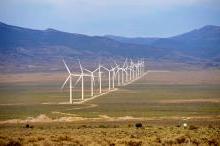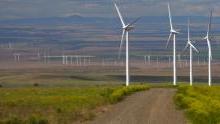这opinion-editorial, by California Energy Commissioner David Hochschild and 澳门百老汇网站网址 Executive Director Nancy Rader, argues that California should promote the revival of California's "pioneer" 1980s wind projects.
新闻
澳门百老汇网站网址 Wins One-Year Extension of PIRP Protective Measures at CAISO

3月15日, 2017, the CAISO Board adopted a one-year extension of its PIRP Protective Measures in response to 澳门百老汇网站网址's advocacy. 澳门百老汇网站网址 was actively engaged in the development of the initial Participating Intermittent Resource Program (“PIRP”) in 2001 and, 三年前, 保护措施. Both programs enable intermittent resources to deliver energy over the CAISO-controlled grid without undue exposure to imbalance charges and related costs.
U.S. Windpower Passes Historic Milestone

U.S. 沙漠计划损害可再生能源
Source: By Nichola Groom, Reuters • Posted: Thursday, September 15, 2016
The United States on Wednesday unveiled a long-awaited plan for desert renewable energy development that the solar and wind industries said unfairly favors land conservation and severely limits the ability to build projects critical to meeting the nation’s climate goals.
The Desert Renewable Energy Conservation Plan, 酝酿了八年, was designed to streamline development of wind and solar projects on federal and private lands in California while preserving pristine desert habitats.
Coalition Says Interior's Desert Plan Reverses Course on Clean Energy Development

经过八年的努力, the Bureau of Land Management’s (BLM) Desert Renewable Energy Conservation Plan (DRECP) will effectively foreclose development of renewable energy resources on millions of acres of federally managed lands in Southern California, said a coalition of renewable energy and labor groups in response to the federal government’s release of the plan. The plan abandons the initial promise to balance renewable development with preservation of desert land.
Renewable developers warn BLM leasing rule may undercut lofty green ambitions
Politico reports that Hillary Clinton's promise of a huge buildout of new solar panels and wind turbines on federally owned deserts and scrublands may be impossible under the land-use strategy that the Obama administration is pursuing, including the Desert Renewable Energy Conservation Plan.
The California Wind Market: Fraught with Promise

Largely credited with launching the industry in the 1980s, wind energy in California is poised for a resurgence. This article by 澳门百老汇网站网址's Nancy Rader and Dariush Shirmohammadi discusses the challenges that must be addressed for wind energy to succeed in California's market for renewable energy.
Legislation Protecting Renewable Energy Facilities Clears First Senate Committee
PRESS RELEASE: SACRAMENTO – Contracts for California’s first wave of renewable energy facilities, built and producing power before the state first adopted its renewable energy targets in 2002, 是到期的, and many facilities are in danger of shutting down because they are locked into low prices.
加州新的联邦法规. desert put too many prime wind energy sites off-limits

A new plan released by the federal Bureau of Land Management (BLM) puts approximately three million acres that had been available for solar and wind development off-limits. 这将使它变得困难, 如果不是不可能的话, to achieve the plan’s stated planning goal of 20,000 MW of renewable energy and presents a challenge to the greenhouse-gas-reduction goals laid out by President Obama and Governor Jerry Brown.
Sacramento Bee opinion editorial argues that wind energy bans cannot be part of a responsible solution to the climate problem
评论文章, by 澳门百老汇网站网址 Executive Director Nancy Rader and Michael Gerrard of the Sabin Center for Climate Change Law at Columbia Law School, highlights the fact that wind energy projects are being banned or severely restricted in several California counties and, 更重要的是, across vast federal lands in the state. These restrictions threaten the ability to achieve California’s climate change goals.